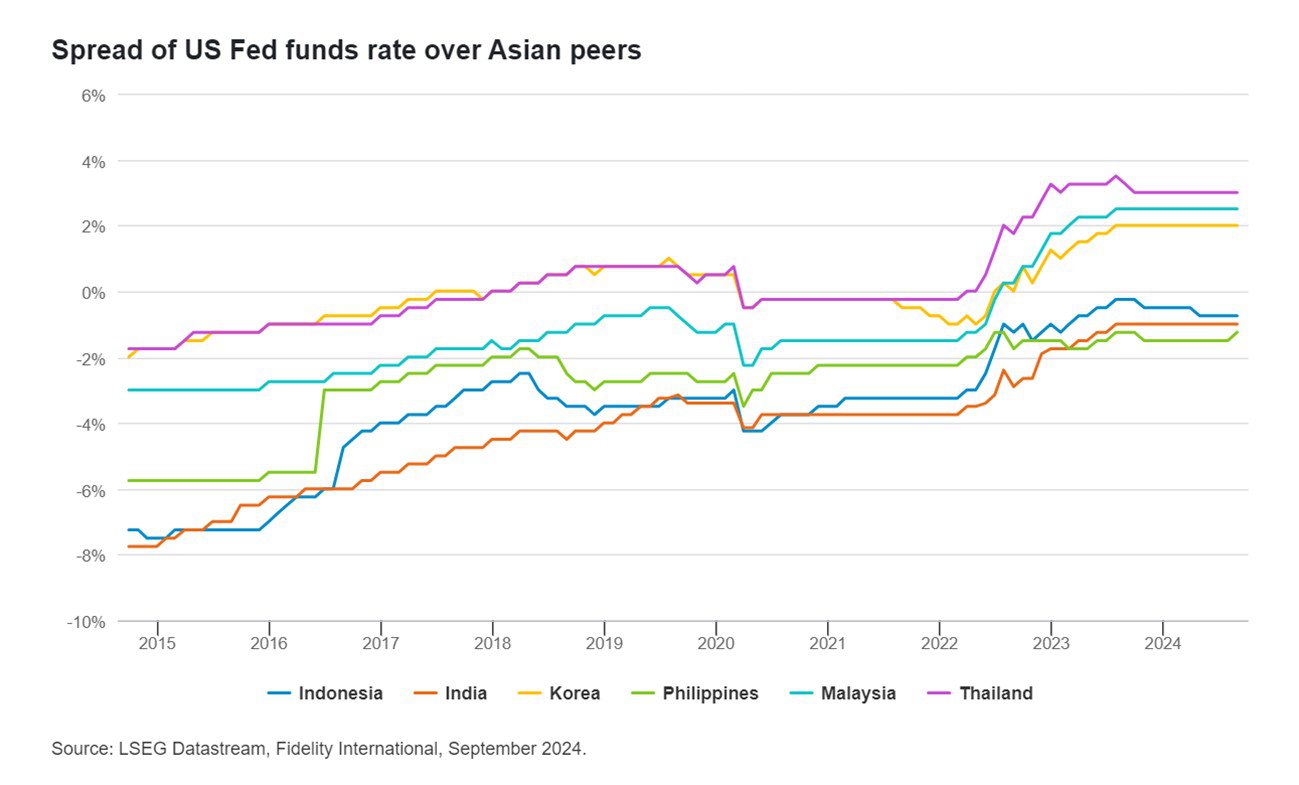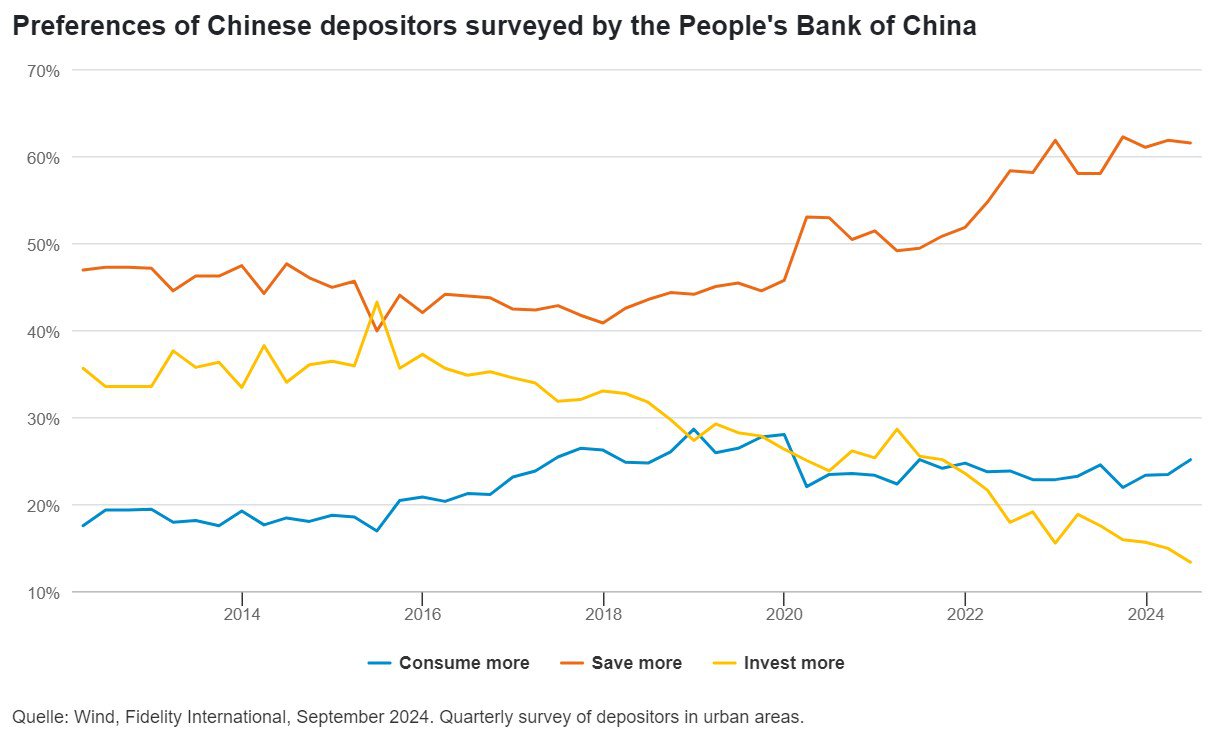 Slow downHow Asia performs also depends, of course, on China and Japan, the two largest economies in the region. China is struggling to gain momentum as consumers and homebuyers remain cautious. With just three months to go until the end of the year, the country’s around 5 per cent annual GDP growth target looks challenging. We’ve lowered the probability of our ‘controlled stabilisation’ base case (from 65 to 55 per cent) and raised the risk of a serious slowdown (to 35 per cent). Reflation remains a remote possibility (at 10 per cent).Chinese policymakers have been working hard to restore confidence. In September, China lowered the downpayment threshold for home purchases, cut interest rates further, and promised to provide more liquidity in the stock market. While China continues to refrain from unleashing huge credit stimulus, these measures underscore officials’ focus on domestic demand, which is supportive for sentiment. ‘Lower for longer’ interest rates - which remain positive when adjusted for inflation - will keep the Chinese bond rally going. For equities, defensive sectors such as banks and utilities are more resilient. More change could come in the October politburo meeting or the Central Economic Work Conference towards the end of the year. But don’t expect drastic policy shifts while external uncertainties, such as the US election, weigh over financial markets.Having escaped the deflation trap, Japan is guarding against inflation, which is set to stay above the Bank of Japan’s 2 per cent target next year. That should lend the BOJ confidence to hike gradually over the coming quarters and draw the country closer to positive real rates. The volatile market reaction to the central bank’s 15-basis point increase in July could slow, but not reverse, Japan’s path on interest rates. In equities, smaller companies that haven’t benefitted as much in the rally over the past year will likely catch up. However, any shift in US trade policy could have implications for Japan, while the change of premiership could present another tail risk for domestic markets.
Slow downHow Asia performs also depends, of course, on China and Japan, the two largest economies in the region. China is struggling to gain momentum as consumers and homebuyers remain cautious. With just three months to go until the end of the year, the country’s around 5 per cent annual GDP growth target looks challenging. We’ve lowered the probability of our ‘controlled stabilisation’ base case (from 65 to 55 per cent) and raised the risk of a serious slowdown (to 35 per cent). Reflation remains a remote possibility (at 10 per cent).Chinese policymakers have been working hard to restore confidence. In September, China lowered the downpayment threshold for home purchases, cut interest rates further, and promised to provide more liquidity in the stock market. While China continues to refrain from unleashing huge credit stimulus, these measures underscore officials’ focus on domestic demand, which is supportive for sentiment. ‘Lower for longer’ interest rates - which remain positive when adjusted for inflation - will keep the Chinese bond rally going. For equities, defensive sectors such as banks and utilities are more resilient. More change could come in the October politburo meeting or the Central Economic Work Conference towards the end of the year. But don’t expect drastic policy shifts while external uncertainties, such as the US election, weigh over financial markets.Having escaped the deflation trap, Japan is guarding against inflation, which is set to stay above the Bank of Japan’s 2 per cent target next year. That should lend the BOJ confidence to hike gradually over the coming quarters and draw the country closer to positive real rates. The volatile market reaction to the central bank’s 15-basis point increase in July could slow, but not reverse, Japan’s path on interest rates. In equities, smaller companies that haven’t benefitted as much in the rally over the past year will likely catch up. However, any shift in US trade policy could have implications for Japan, while the change of premiership could present another tail risk for domestic markets. Structural storiesThe promise of structural forces supporting Asia is real, from the demographic dividend in India and Southeast Asia, to the advent of AI and the energy transition. But as markets grow more alive to near-term risks, we expect more scrutiny of these structural stories. We’ve already seen this play out in AI, as investors rotated out of semiconductor-heavy Taiwan and Korea, and into Asean markets expecting a more imminent boost from monetary policy.Likewise, we are hopeful on India’s long-term prospects. Its fundamentals are solid and its pace of growth - forecast at 7 per cent this year - is not to be scoffed at. But after an extended rally, valuations in some corners of the stock market may be too hot to handle. Lurking in the background is the risk from the unwinding yen carry trade, as speculators exit popular - and crowded - stock markets. The outlook for Indian bonds may be more favourable on the back of their addition to global benchmarks and positive real interest rates.Want to search and invest in related funds?Open the WeLab Bank App and click【Featured Funds】to find out more!
Structural storiesThe promise of structural forces supporting Asia is real, from the demographic dividend in India and Southeast Asia, to the advent of AI and the energy transition. But as markets grow more alive to near-term risks, we expect more scrutiny of these structural stories. We’ve already seen this play out in AI, as investors rotated out of semiconductor-heavy Taiwan and Korea, and into Asean markets expecting a more imminent boost from monetary policy.Likewise, we are hopeful on India’s long-term prospects. Its fundamentals are solid and its pace of growth - forecast at 7 per cent this year - is not to be scoffed at. But after an extended rally, valuations in some corners of the stock market may be too hot to handle. Lurking in the background is the risk from the unwinding yen carry trade, as speculators exit popular - and crowded - stock markets. The outlook for Indian bonds may be more favourable on the back of their addition to global benchmarks and positive real interest rates.Want to search and invest in related funds?Open the WeLab Bank App and click【Featured Funds】to find out more!Importance NoticeThis document is for general information only. The information or opinion herein is not to be construed as professional investment advice or any offer, solicitation, recommendation, comment or any guarantee to the purchase or sale of any investment products or services. This document is for general evaluation only. It does not take into account the specific investment objectives, financial situation or particular needs of any particular person or class of persons and it has not been prepared for any particular person or class of persons. The investment products or services mentioned in this webpage are not equivalent to, nor should it be treated as a substitute for, time deposit, and are not protected by the Deposit Protection Scheme in Hong Kong.The information or opinion presented has been developed internally and/or taken from sources (including but not limited to information providers and fund houses) believed to be reliable by WeLab Bank, but WeLab Bank makes no warranties or representation as to the accuracy, correctness, reliabilities or otherwise with respect to such information or opinion, and assume no responsibility for any omissions or errors in the content of this document. WeLab Bank does not take responsibility for nor does WeLab Bank endorse such information or opinion.Investment involves risks. The price of an investment fund unit may go up as well as down and the investment funds may become valueless. Past performance is not indicative of future results. WeLab Bank makes no representation or warranty regarding future performance. Any forecast contained herein as to likely future movements in interest rates, foreign exchange rates or market prices or likely future events or occurrences constitutes an opinion only and is not indicative of actual future movements in interest rates, foreign exchange rates or market prices or actual future events or occurrences (as the case may be).You should not make any investment decision purely based on this document. Before making any investment decisions, you should consider your own financial situation, investment objectives and experiences, risk acceptance and ability to understand the nature and risks of the relevant product(s). WeLab Bank accepts no liability for any direct, special, indirect, consequential, incidental damages or other loss or damages of any kind arising from any use of or reliance on the information or opinion herein. You should seek advice from independent financial adviser if needed.WeLab Bank is an authorised institution under Part IV of the Banking Ordinance and a registered institution under the Securities and Futures Ordinance (CE Number: BOJ558) to conduct Type 1 (dealing in securities) and Type 4 (advising on securities) regulated activities.This document is issued by WeLab Bank. The contents of this document have not been reviewed by the Securities and Futures Commission in Hong Kong.

